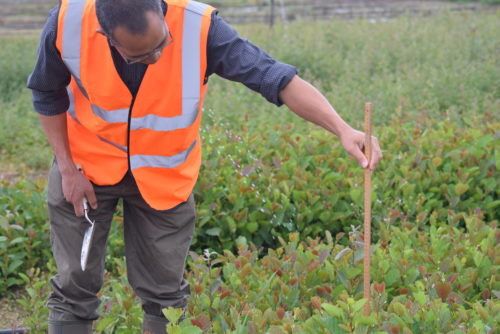Danielle Stoddart is a Crop Technician at Maelor Forest Nurseries. Danielle provides the answers to questions around where she started, day-to-day job role and some of the important projects in place at the commercial tree nursery in Wrexham.
Can you give us some background about you? Where did you start, what were your previous jobs/education and what led you to Maelor?
I chose the subject that I most enjoyed at school – Geography to study at university. I then chose physical geography modules such as ‘Biodiversity and Conservation Management’ and ‘Climate Change in the Earth System.’
Based on what I was learning I decided I wanted to work ‘outside with trees,’ I was not sure at that stage what that job would be.
I received some useful experience with a work placement looking at the carbon content of an arboretum and volunteering at the Birmingham Institute of Forest Research, helping them investigate the effects of carbon enrichment on naturally regenerated seedlings.
Once I graduated and started job hunting I found the position at Maelor, in March 2020, just before the first lockdown, which seemed an interesting opportunity.
What does your day-to-day job entail?
My key role (along with the Agronomy Manager) is to walk the crops looking for any issues, the focus is on tree health, weeds, and disease presence.
As a team (including our spray co-ordinator) we use these notes to plan out any field work that needs doing, spraying, weeding, etc. We also use other tools to monitor the crops, such as soil moisture sensors.
I look after the trials we have including pesticide trials – we are always looking for products that are safe on the trees, effective, and more environmentally friendly; and forest trials looking into the performance of alternative conifers owing to the changing climate, and treatments for Hylobius – a hugely damaging forest pest.
The work is really varied – tree health and biosecurity, planning field work, trials, quality assurance, working with collaborators, and the associated admin work that goes with all of that. This week we are grafting trees to make sure our seed orchards are fully stocked.
Tell us about some of the wider things you are working on?
We are working on a way to best use the drone we have. We would like to use it for stock taking and monitoring crop health to help plan where to plant out the crops. It is an ongoing project as it seems a first for forest nurseries!
As part of the Conifer Breeding Co-operative we maintain seed orchards and clonal archives. These supply us with the seed we use in our Somatic Embryogenesis lab and are a source of improved forest reproductive material.
We are in the process of planning another seed orchard to be set up here at Maelor.
As part of another trial, we are looking at the impact that mycorrhiza could have on tree health, from the nursery to the final planting site. This is in collaboration with Rhizocore (who are producing the mycorrhizal product) and Tilhill.
What is the favourite part of your job?
How varied it is, every day is different and the work changes with the season. I really appreciate being able to go from sitting at a desk to getting outside and involved with more practical work, I am also always learning something new, which I love!
 https://www.maelor.co.uk/wp-content/uploads/2023/08/Norway-spruce-donning-its-spring-clothes-500x375.jpg
https://www.maelor.co.uk/wp-content/uploads/2023/08/Norway-spruce-donning-its-spring-clothes-500x375.jpg








